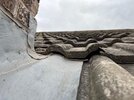Hello all, I would appreciate comments on the likely quality of some leadwork around a couple of chimneys on external walls. There has long been some damp getting in at eave level and soaking into plasterboard ceiling so I had the old felt replaced with membrane and the lead replaced around the chimneys. However, this has not solved the problem and has in fact made it worse as, in heavy rain, water now clearly runs down a line of bricks visible at the back of the chimneys in the loft. The company have been 'reasonable' so far and have come out a few times and made some up-turns at the edges of the back apron but it has not solved the leak. Having looked at some Youtube videos of super work by professionals I am not convinced the work at my chimneys is as it should be. So, some second opinions would be very welcome - pics attached;
Attachments
-
 IMG_4010.jpg267.2 KB · Views: 168
IMG_4010.jpg267.2 KB · Views: 168 -
 IMG_4114.jpg137 KB · Views: 168
IMG_4114.jpg137 KB · Views: 168 -
 IMG_4011.jpg99 KB · Views: 159
IMG_4011.jpg99 KB · Views: 159 -
 IMG_4014.jpg182.5 KB · Views: 158
IMG_4014.jpg182.5 KB · Views: 158 -
 IMG_4020.jpg136.5 KB · Views: 144
IMG_4020.jpg136.5 KB · Views: 144 -
 IMG_4021.jpg82 KB · Views: 142
IMG_4021.jpg82 KB · Views: 142 -
 IMG_4012.jpg51.8 KB · Views: 135
IMG_4012.jpg51.8 KB · Views: 135 -
 IMG_4013.jpg182 KB · Views: 122
IMG_4013.jpg182 KB · Views: 122 -
 IMG_4023.jpg171.3 KB · Views: 122
IMG_4023.jpg171.3 KB · Views: 122 -
 IMG_4016.jpg185.8 KB · Views: 157
IMG_4016.jpg185.8 KB · Views: 157

